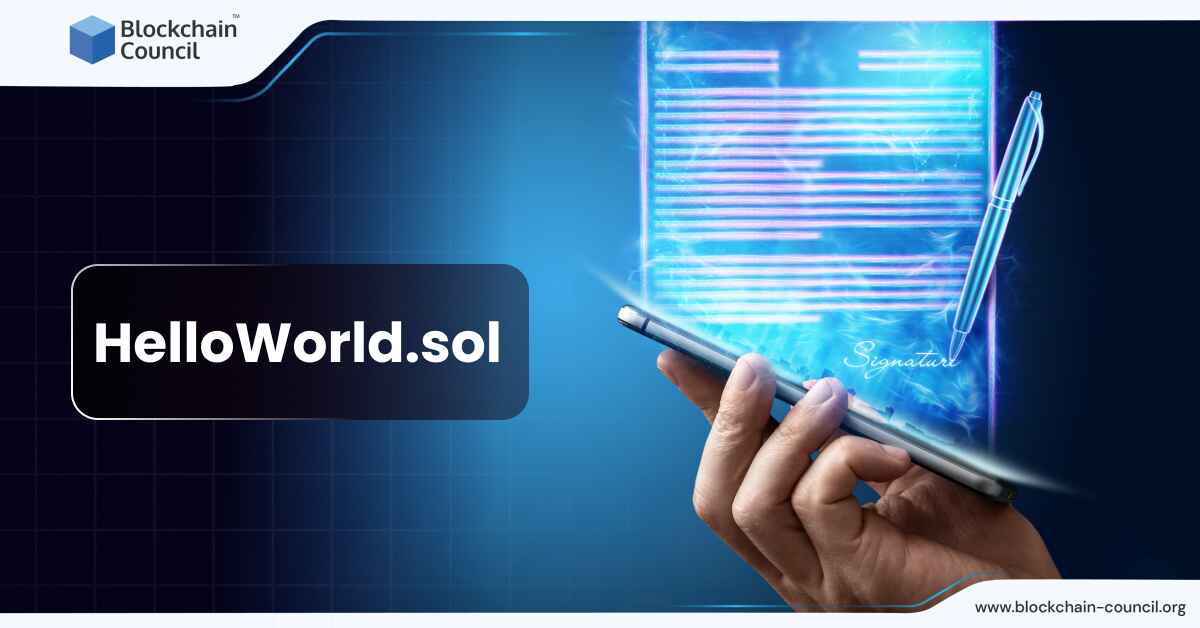
- Blockchain Council
- August 22, 2024
Understanding how to create and deploy a smart contract is an essential skill for any developer venturing into the world of Blockchain technology. The simplest and most common entry point into Solidity, Ethereum’s programming language, is through the creation of a “Hello World” smart contract.
What is HelloWorld.sol?
“HelloWorld.sol” is the filename commonly associated with the first smart contract many developers create when learning Solidity. This file contains the code for a simple smart contract written in Solidity that performs a very basic function: it stores and returns a string—usually the text “Hello, World!”—when called. Although this contract might seem trivial, it introduces the core concepts of Solidity programming, including contract structure, functions, and deployment.
HelloWorld.sol is essentially a minimalistic example, aimed at demonstrating the core concepts of Solidity without overwhelming the learner. By understanding this basic contract, you set the stage for developing more sophisticated applications.
Understanding the Solidity Programming Language
Solidity is a statically-typed programming language designed specifically for creating smart contracts that run on the Ethereum Virtual Machine (EVM). It is influenced by languages such as C++, Python, and JavaScript, making it relatively easy for developers familiar with these languages to learn. Solidity allows for the creation of contracts that can handle anything from simple storage of data to more complex operations like interacting with other contracts or implementing decentralized applications (dApps).
In “HelloWorld.sol,” the Solidity language showcases its basic structure through the declaration of a contract, the use of functions, and the interaction with the Blockchain. This contract introduces beginners to key aspects such as versioning with pragma, defining a contract with contract, and writing a basic function that can return a message. And to learn how to learn the ins and outs of smart contract and earn big in this field, consider getting certified through an expert recommended certification program like the Certified Solidity Developer™.
Creating the HelloWorld.sol Smart Contract
Creating a “HelloWorld.sol” smart contract typically begins with setting up a development environment.
1. Prerequisites
Before diving into the creation process, ensure that you have the necessary tools installed:
- Node.js and npm: These are required to manage JavaScript libraries.
- Solidity: The programming language for writing smart contracts.
- Remix IDE: A web-based tool that helps write, compile, and deploy Solidity contracts.
2. Setting Up the Environment
Using Remix IDE
Remix is an online integrated development environment (IDE) specifically designed for Solidity. It’s browser-based, making it accessible without the need to install additional software.
- Visit the Remix IDE website: Go to Remix IDE.
- Create a new file: In the file explorer, create a new file named HelloWorld.sol.
- Write the Smart Contract: In this file, write the following Solidity code:
// SPDX-License-Identifier: MIT
pragma solidity ^0.8.13;
contract HelloWorld {
function sayHelloWorld() public pure returns (string memory) {
return “Hello, World!”;
}
}
This contract includes a simple function, sayHelloWorld, which returns the string “Hello, World!” when called.
3. Using Hardhat for Deployment
Hardhat is a popular Ethereum development environment that allows you to deploy and test smart contracts locally before deploying them on a live Blockchain.
A. Install Hardhat:
npm init -y
npm install –save-dev hardhat
After installation, initialize a new Hardhat project:
npx hardhat
Choose “Create an empty hardhat.config.js”.
B. Create Your Contract
Inside your project directory, create a folder named contracts. Within this folder, create a file called HelloWorld.sol and paste the Solidity code mentioned earlier.
4. Deploy the Contract
To deploy the contract, create a deployment script in a scripts directory. Name the script deploy.js:
async function main() {
const HelloWorld = await ethers.getContractFactory(“HelloWorld”);
const hello = await HelloWorld.deploy();
console.log(“Contract deployed to address:”, hello.address);
}
main()
.then(() => process.exit(0))
.catch(error => {
console.error(error);
process.exit(1);
});
Run the deployment script:
npx hardhat run scripts/deploy.js –network localhost
4. Compiling and Deploying the Contract
Once your code is ready, the next step is to compile and deploy it.
Compiling with Remix
In Remix, compiling is straightforward:
- Select the Solidity Compiler: On the left sidebar, click on the “Solidity Compiler” tab.
- Compile the Contract: Ensure the correct Solidity version is selected, then click “Compile HelloWorld.sol”. A successful compilation will display a green checkmark.
Deploying with Remix
Deploying in Remix is also simple:
- Deploy the Contract: Click on the “Deploy & Run Transactions” tab.
- Deploy to the Blockchain: Ensure “HelloWorld” is selected, then click “Deploy”. This action will deploy the contract to the selected blockchain.
5. Testing the Contract
After deployment, you can interact with your contract directly in Remix. Under “Deployed Contracts”, you’ll see your contract listed. Expand it and click sayHelloWorld(). The output should display “Hello, World!”.
Practical Applications and Next Steps
While the “Hello World” contract might seem simplistic, it serves as a gateway to more complex Blockchain development. Understanding how to create, deploy, and interact with this contract sets the stage for building more intricate smart contracts that can handle data storage, token creation, and decentralized finance applications. If you want to learn more
After mastering “HelloWorld.sol,” developers can explore further by:
- Modifying the Contract: Experiment with adding more functions, such as updating the greeting variable, or incorporating additional logic.
- Deploying to a Testnet: Moving beyond the local or browser-based environments and deploying the contract to a test network like Ropsten or Rinkeby allows for real-world interaction without risking real assets.
- Learning Solidity Advanced Features: Take a step ahead into Solidity by learning about inheritance, libraries, and more complex data types and enrolling into expert recommended certifications like the Certified Solidity Developer™.
Conclusion
HelloWorld.sol, though simple, plays a crucial role in the Blockchain ecosystem. It is a fundamental step in understanding how smart contracts function within the Ethereum ecosystem. By starting with this simple contract, developers gain the confidence and skills necessary to explore the broader and more complex world of Blockchain programming. With the basics mastered, the path to building powerful decentralized applications becomes clear and attainable.




































































 Guides
Guides News
News Blockchain
Blockchain Cryptocurrency
& Digital Assets
Cryptocurrency
& Digital Assets Web3
Web3 Metaverse & NFTs
Metaverse & NFTs
